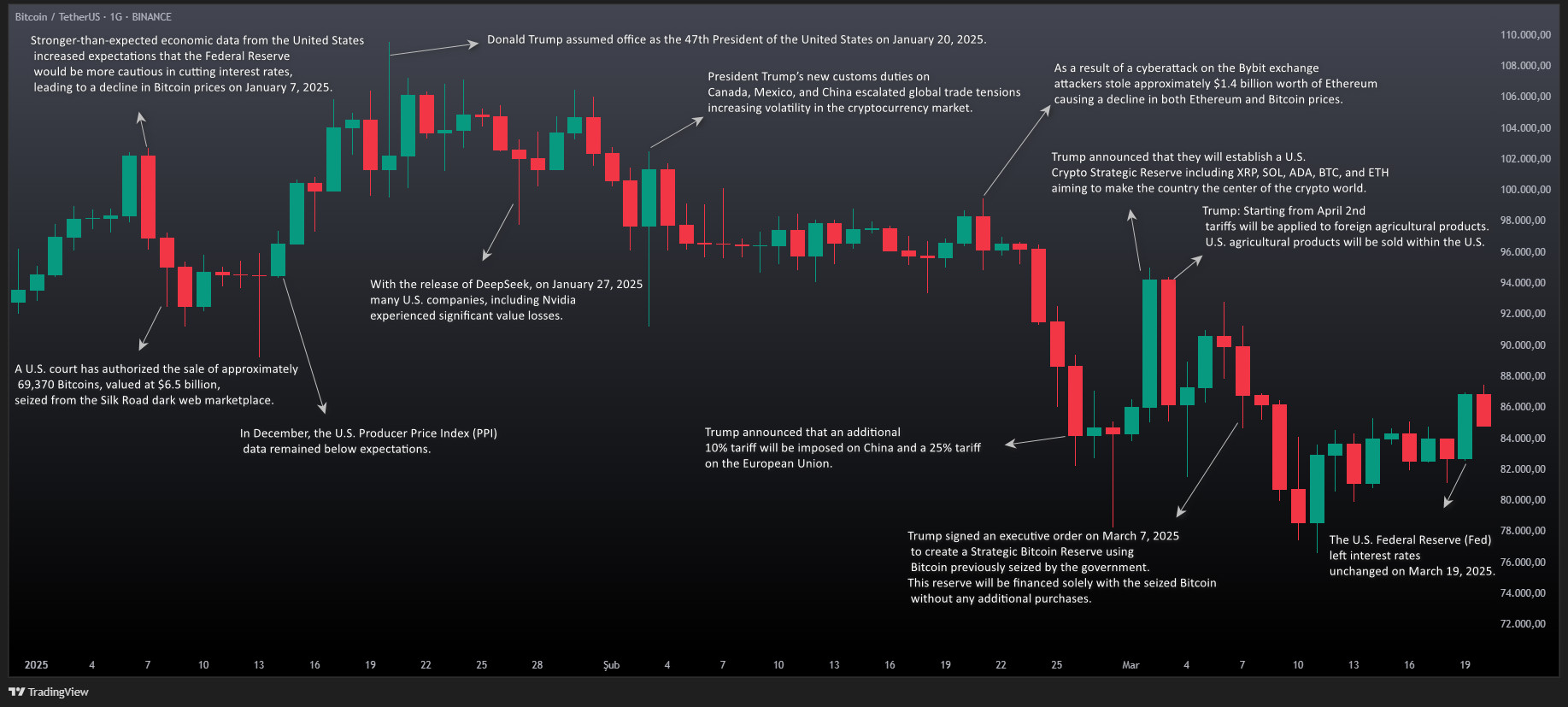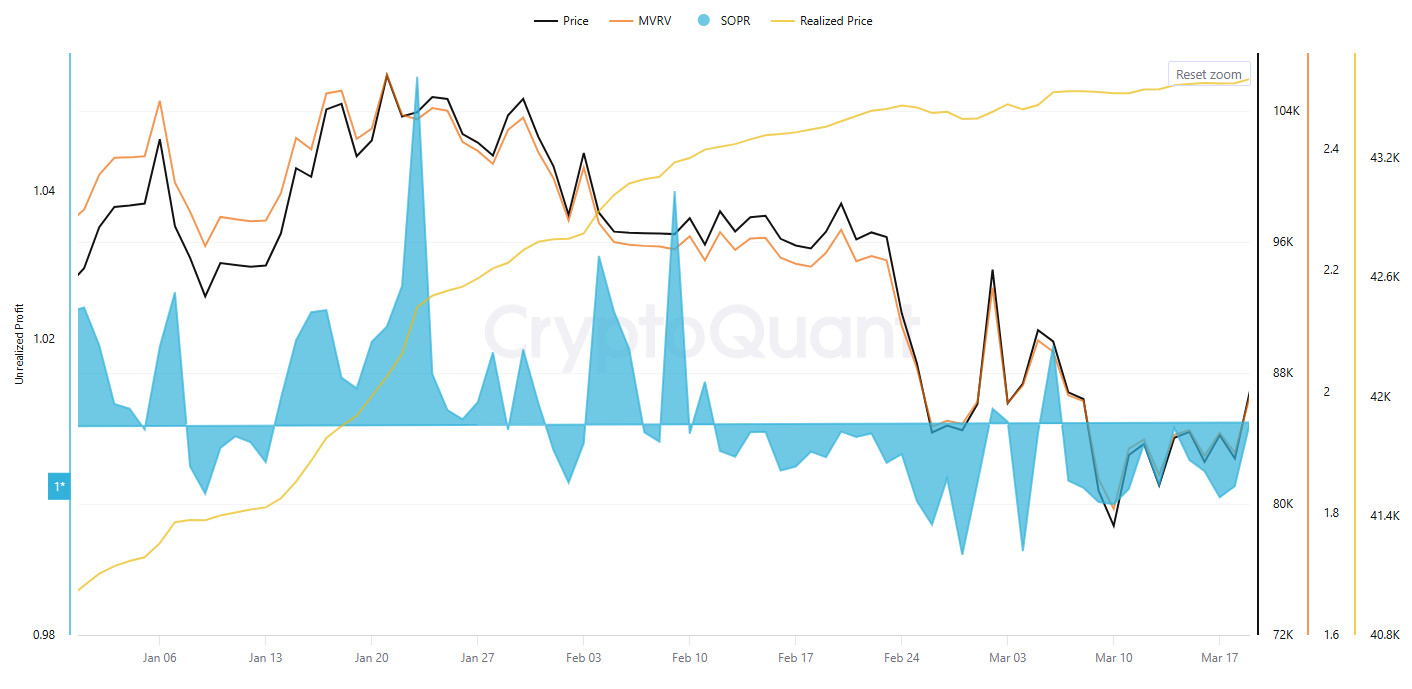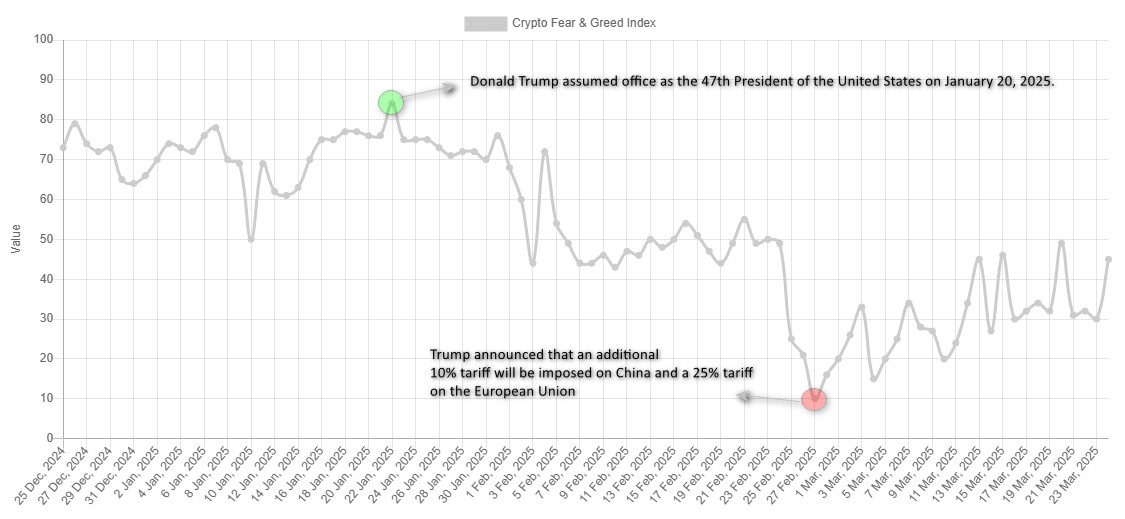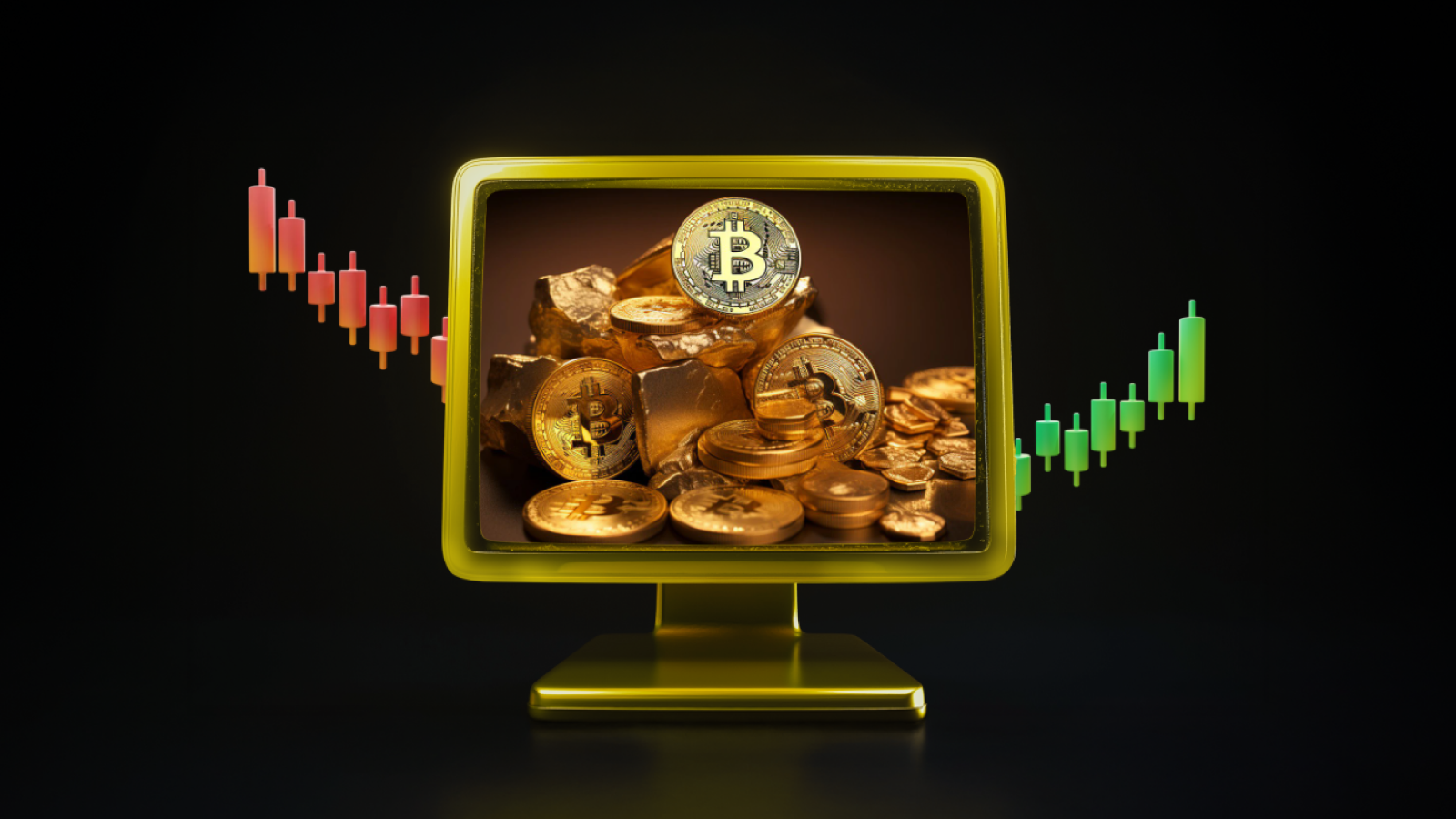Introduction
The first quarter of 2025 witnessed intense volatility in the Bitcoin market. Macroeconomic developments, political events and market dynamics had a significant impact on the Bitcoin price. The US presidential transition, the Federal Reserve’s interest rate policies, stock market cyberattacks and international trade tensions were among the determinants of Bitcoin’s price movements. In this analysis, we will take a detailed look at key events in the Bitcoin market in the first quarter of 2025, on-chain data and indices that measure investor sentiment.
Bitcoin and Global Impacts in the First Quarter of 2025

The first quarter of 2025 was characterized by intense macroeconomic and political developments for Bitcoin. Between January 1 and March 20, there was a 10% drop in the Bitcoin price. During this period, Bitcoin peaked at $109,588, but the increasing uncertainties in the market, especially after Donald Trump took over the US presidency on January 20, caused the price to fall as low as $76,606.
Strong economic data from the US in early January raised markets’ expectations that the Federal Reserve would be cautious in cutting interest rates. The higher-than-expected JOLTS Job Openings data and ISM Services PMI data reinforced concerns that rate cuts may be delayed. This triggered a flight from risky assets, leading to a decline in Bitcoin price. In the same period, the US court’s approval of the sale of 69,370 Bitcoins (approximately $6.5 billion) seized in the Silk Road operation increased the selling pressure in the market and accelerated the decline.
On January 20, Donald Trump’s inauguration increased volatility in the markets. Uncertainties about the new administration’s economic policies and steps to reignite global trade wars led to fluctuations in the markets. Launched on January 27, the artificial intelligence model DeepSeek caused sharp losses in major technology companies such as Nvidia, putting pressure on Bitcoin and other digital assets. The Trump administration’s announcement of new tariffs on Canada, Mexico and China increased tensions in global trade and shook investor confidence.
The Bybit exchange attack in February caused a loss of confidence in the markets. The theft of $1.4 billion worth of Ethereum led to sharp declines in Bitcoin and other major crypto assets. The Trump administration’s announcement of 10% tariffs on China and 25% tariffs on the European Union had a negative impact on global markets. These developments accelerated the exit of investors from risky assets, causing Bitcoin to fall below $80,000.
In March, the Trump administration took an important step towards the crypto market. On March 7, a presidential decree announced the creation of a “Strategic Bitcoin Reserve” using Bitcoins seized from Silk Road. However, it was announced that the US aims to establish a “Crypto Strategic Reserve” that includes major crypto assets such as XRP, Solana (SOL), Cardano (ADA), Bitcoin (BTC) and Ethereum (ETH). Although this move shows that the US is pursuing a long-term strategy towards the crypto market, its impact on the markets was limited.
On March 19, the Federal Reserve’s decision to leave interest rates unchanged led to a brief market rebound, but the overall downtrend continued. Declining risk appetite in a high-interest rate environment and the Trump administration’s aggressive trade policies caused Bitcoin to fall as low as $76,606. These developments in the first quarter gave important signals about the direction the Bitcoin market will follow throughout 2025. In particular, the global economy, US regulatory policies and interest rate decisions of central banks will continue to be decisive on crypto markets.

Market Capitalization and Earnings
In the first quarter of 2025, Bitcoin’s on-chain data signaled a decline in investor profitability and market stabilization. The Bitcoin price fell from $94,394 to $86,923, a decline of about 7.9%. The MVRV ratio fell from 2.29 to 1.99, indicating a decrease in the average profitability of investors and a reduced risk of overvaluation. The Realized Price increased from $41.049 to $43.598, indicating that long-term investors were buying. The SOPR metric declined from 1.02 to 1.00, indicating that selling in the market was largely taking place at breakeven.
Overall, the on-chain data suggests that profit realization in the Bitcoin market is waning, and investors are becoming more cautious.
Money Flows in Bitcoin and Ethereum ETFs

An analysis of capital flows into Bitcoin spot ETFs in the first quarter of 2025 shows that the highest inflow was recorded on January 17 with $1.08 billion. A total of $1.967 billion worth of inflows were recorded in the week of January 17, which can be attributed to the expectations for Donald Trump to take over the administration on January 20 and the positive atmosphere in the markets regarding the potential creation of Bitcoin reserves. On the other hand, the largest outflow was $1.14 billion on February 25. During this period, the theft of approximately $1.4 billion worth of Ethereum as a result of a cyber-attack on the Bybit exchange on February 21 caused a decline in both Ethereum and Bitcoin prices, negatively affecting investor confidence. Subsequently, a total outflow of $2.615 billion occurred in the week of February 24-28. In this period, Donald Trump’s announcement of additional 10% tariffs on China and 25% tariffs on the European Union may have further accelerated capital outflows. In line with all these developments, Bitcoin spot ETFs realized a net inflow of $2.4 billion in the first quarter.

In the first quarter, Ethereum spot ETFs saw the highest outflows on January 8 and the highest inflows on February 4. On January 8, strong economic data from the US led to a general decline in the cryptocurrency market as investors expected the Fed to be cautious in cutting interest rates. This negatively impacted interest in Ethereum spot ETFs, with outflows totaling $159.3 million. Most of this outflow came from FETH, Fidelity’s Ethereum ETF. On the other hand, the successful deployment of the EIP-4844 update on testnets on February 4 boosted investor confidence with the potential to improve the scalability and transaction costs of the Ethereum network. This revitalized interest in Ethereum, leading to an increase in daily net inflows to $307.77 million.

Sharp Changes in the Fear & Greed Index and Market Reactions
The Fear & Greed index fluctuated in the first quarter, clearly reflecting shifts in market psychology. At 66 at the beginning of the quarter, the index indicated that investors had high confidence in the market and were inclined to take risks. With Trump’s inauguration as US President on January 20, 2025, the index rose to 84, marking a period of peak greed. However, from this point onwards, the index gradually declined due to developments that put pressure on the market.
First, with the launch of Deep Seek on January 27th, many major tech companies in the US, especially Nvidia, lost value, putting pressure on the market. Then, Trump’s new tariffs in Canada, Mexico and China increased global trade tensions, causing volatility in the crypto market. During this period, a large-scale cyberattack on the Bybit exchange and the theft of $1.4 billion worth of Ethereum led to sharp declines in both Ethereum and Bitcoin prices. Finally, Trump’s announcement of additional tariffs on China and the European Union further increased uncertainty in the markets and pushed the index down to 10.
These events over the course of the quarter caused a sharp shift in investor sentiment. The market shifted from extreme greed to fear, marking a period of heightened uncertainty and reduced risk appetite. However, by the end of the quarter, the index had recovered to around 45, indicating that some balance had been restored to the market. This suggests that investors are shifting away from excessive fear and towards a more cautious optimism, and that the market is entering a recovery phase.
Conclusion and Evaluation
The first quarter of 2025 was a period of high uncertainty and volatility in the Bitcoin market. Macroeconomic factors, political developments and market conditions significantly affected Bitcoin’s price movements. Increasing policy uncertainties with the Trump administration taking office, the Federal Reserve’s interest rate decisions and stock market cyberattacks put pressure on Bitcoin and other crypto assets. In addition, on-chain data showed that the market is stabilizing and investors are becoming more cautious.
Although capital flows into Bitcoin spot ETFs fluctuated, the net inflow of $2.4 billion signaled that the market was still optimistic about long-term prospects. Likewise, the Fear & Greed index fluctuated sharply during the quarter but stabilized somewhat by the end of the period.
Overall, in the first quarter of 2025, the Bitcoin market has gone through significant trials and, despite high volatility, is well on its way to finding a certain equilibrium. The impact of macroeconomic uncertainties and regulatory policies on crypto assets will continue to be closely monitored and will be among the most important factors that will determine the course of the market later in 2025.
Disclaimer
This content is for informational purposes only and is not investment or financial advice. All investment decisions and risks belong solely to the reader.





